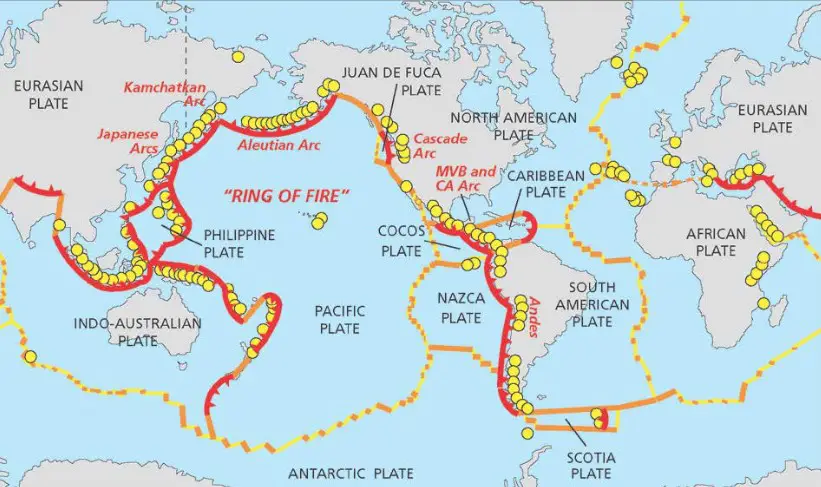The Earth’s surface is a dynamic and ever-changing environment. One of the most significant phenomena that occur is the occurrence of earthquakes and volcanoes. In this blog, we will explore the relationship between the locations of earthquakes and volcanoes and how they are related to each other.
We’ll discuss the scientific theories behind why and how they occur, and how they interact with each other to shape the landscape of our planet.
Overview of major earthquake and volcano hotspots

It is a well-known fact that earthquakes and volcanoes are closely related. Earthquakes can trigger eruptions, while volcanic eruptions can cause earthquakes. As such, it is not surprising to find that the locations of earthquakes and volcanoes are often closely linked.
As such, it is not surprising to find that the locations of earthquakes and volcanoes are often closely linked. In fact, many of the world’s major hotspots for seismic and volcanic activity are located in the same areas. These regions are typically located along the edges of tectonic plates, which are constantly shifting and causing seismic activity and volcanic eruptions.
Examples of such regions include the Pacific Ring of Fire, the Mediterranean, and the Alpide belt. All of these regions are heavily seismically and volcanically active, making them some of the most hazardous zones on Earth.
Identifying the causes of earthquakes and volcanoes

Earthquakes and volcanoes are two of the most destructive natural disasters that can occur on earth. It is important to understand the relationship between the two in order to better prepare for and prevent them. While earthquakes and volcanoes can occur independently, there is often a connection between their locations.
Generally, earthquakes occur at plate boundaries, where two tectonic plates meet, while volcanoes are more commonly found at hot spots, which are areas of intense heat and volcanic activity deep within the earth. When two plates collide, the pressure can cause earthquakes and volcanoes can form as a result of magma forced up through the earth’s crust.
Additionally, the movement of the plates can cause vibrations that can lead to earthquakes. Therefore, it can be said that there is a definite relationship between the locations of earthquakes and volcanoes.
Exploring the connection between earthquakes and volcanoes

Earthquakes and volcanoes are two of the most powerful and destructive forces of nature that have shaped the planet over millions of years. While these two phenomena seem unrelated, there is actually a strong connection between the locations of earthquakes and volcanoes.
In essence, earthquakes and volcanoes often happen close together because they are both caused by the same underlying tectonic activity. As magma and other molten material move beneath the Earth’s surface, it can create shifts in the tectonic plates that cause both earthquakes and volcanoes. Therefore, when examining the relationship between earthquakes and volcanoes, it is important to consider the underlying geological processes that cause both of these phenomena.
The effects of earthquakes and volcanoes on the environment

The relationship between earthquakes and volcanoes is an intricate one. Earthquakes can be caused by the movement of tectonic plates and can trigger volcanic eruptions. On the other hand, volcanic eruptions can also cause earthquakes due to the shifting of the earth.
The combination of earthquakes and volcanoes can cause devastating effects on the environment, including landslides, tsunamis, and even flooding. Earthquakes and volcanoes can also disrupt ecosystems, cause destruction of property, and contaminate water sources.
It is important to be aware of the relationship between these two natural disasters in order to be prepared and protect ourselves and the environment.
Preparing for earthquakes and volcanoes

Earthquakes and volcanoes often go hand in hand, as their locations are closely related. Earthquakes occur when tectonic plates, which are large pieces of the Earth’s crust, rub against each other or break apart, causing the ground to shake.
Volcanoes, on the other hand, form when molten rock, known as magma, rises from deep within the Earth’s crust and reaches the surface. When this happens, the pressure of the magma can cause the ground to break and an eruption can occur. It’s no coincidence then, that earthquakes and volcanoes often occur in the same region, as they both result from the same geologic activity.
Therefore, if you are living in an area prone to earthquakes, it’s important to be aware of the potential risks of volcanic activity as well. Preparing for both earthquakes and volcanoes is essential, as they can cause serious destruction and disrupt lives.
Bottom Line
The relationship between earthquakes and volcanoes is complex and closely intertwined. Earthquakes often occur in the vicinity of active volcanoes due to tectonic activity in the Earth’s crust, and the eruptions of volcanoes can in turn cause seismic activity. Seismic activity can also trigger volcanic eruptions.
Seismic activity can also trigger volcanic eruptions. The study of this relationship helps us to better understand the Earth’s geology and geophysical dynamics.

